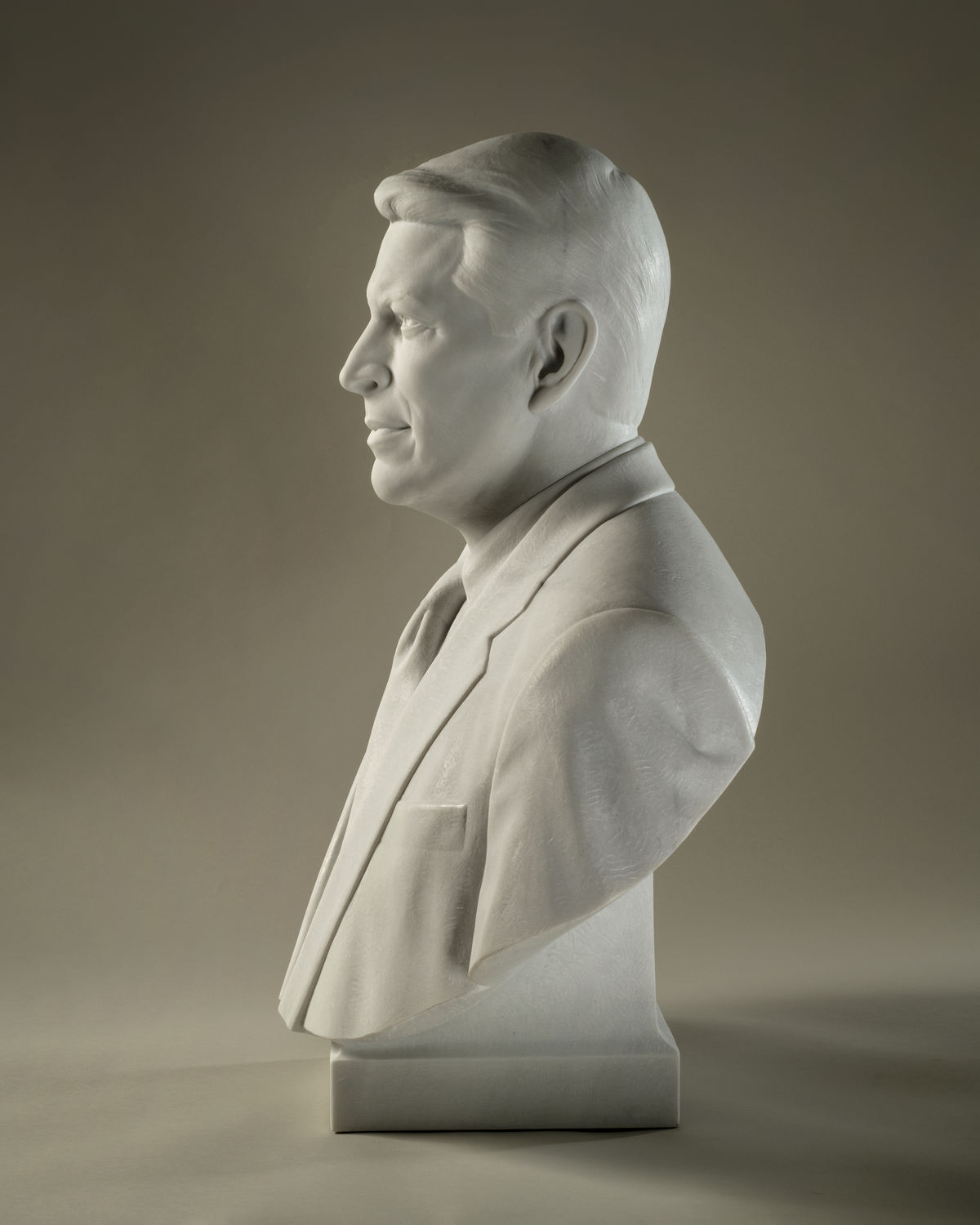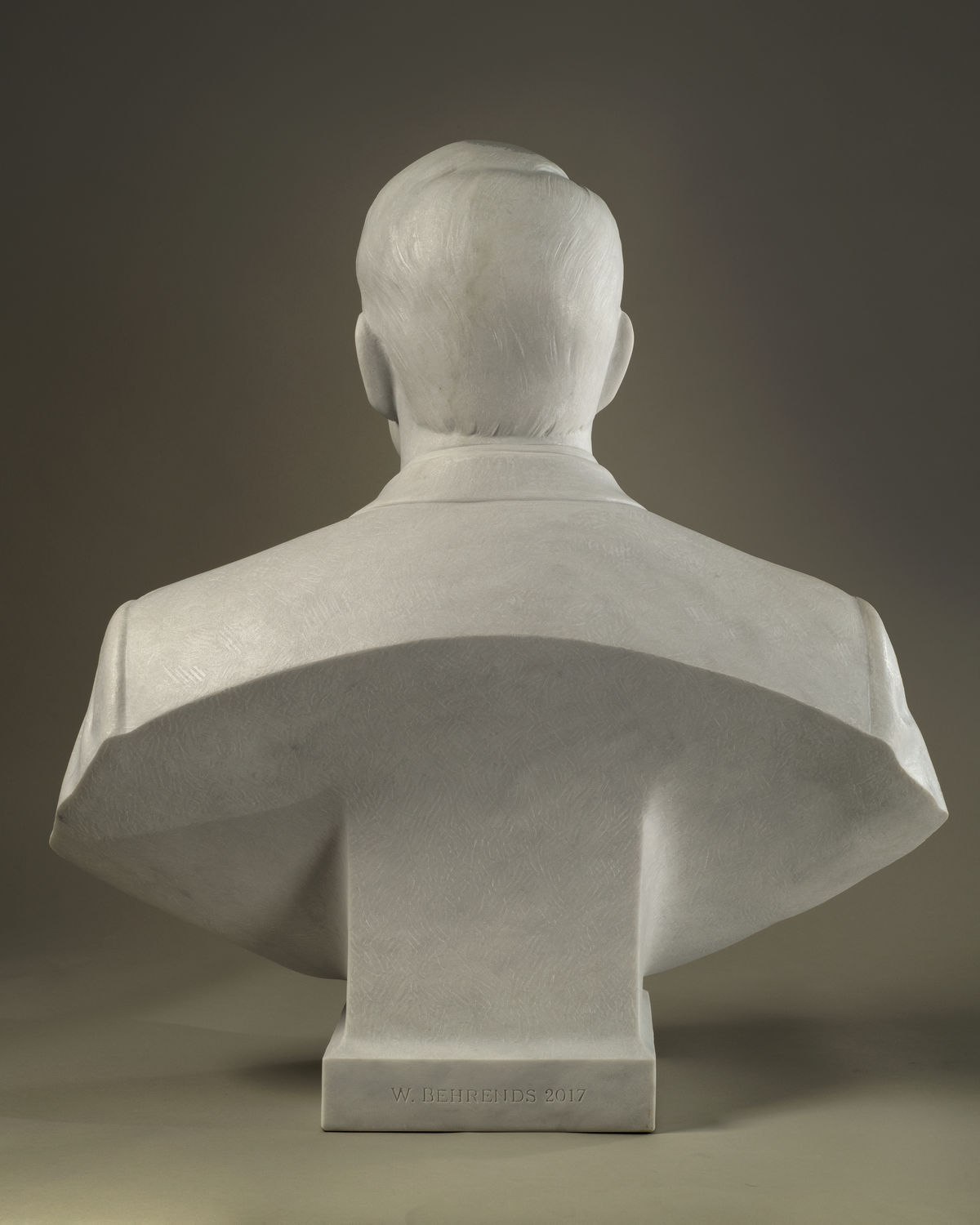






| Title | Albert A. Gore, Jr. |
| Artist/Maker | William Frederick Behrends ( 1946 - Present ) |
| Date | 2017 (carved), 2016 (modeled) |
| Medium | Marble |
| Dimensions | h. 30 x w. 27.5 x d. 14 in. (h. 76.2 x w. 69.9 x d. 35.6 cm) |
| Credit Line | U.S. Senate Collection |
| Accession Number | 22.00046.000 |
Albert A. Gore, Jr. selected William Behrends to sculpt his portrait in marble for the Senate’s Vice Presidential Bust Collection in 2011. Sittings for the bust, held in the former vice president’s home in Nashville, Tennessee, enabled the sculptor to create a full-scale model of Gore’s head and shoulders in clay. In order to render an accurate likeness, Behrends also referenced photographs of Gore during his two terms as vice president from 1993 to 2001 under President William J. Clinton.
Following approval by the vice president of the full-sized clay model in November of 2016, Behrends used the clay portrait to create a plaster cast that would guide him when carving the marble bust. The artist traveled to Italy to select the marble block, where he completed the initial carving and reduced the nearly 1,200-pound marble to less than a third of its weight. Behrends then completed the finer details in his North Carolina studio using a set of vintage handmade chisels, a cherished gift from master Italian carver Pasquino Pasquini. The completed marble bust was accepted by the Senate Committee on Rules and Administration in 2018 and placed on view in the Senate wing of the Capitol in 2022.
Behrends studied architecture at North Carolina State University and completed his academic studies in fine arts and sculpture at the University of North Carolina at Chapel Hill. He furthered his training in Pietrasanta, south of Carrara, Italy, where carvers of fine sculpture still follow traditional methods. He currently maintains a studio in Tyron, North Carolina. Other works by the sculptor include a monumental bronze bust of Andrew Johnson at the Tennessee State Capitol, a statue of Henry Ford II at Ford World Headquarters in Detroit, and a bronze statue of Buck O’Neil at the National Baseball Hall of Fame in Cooperstown, New York. Behrends has completed three vice presidential busts for the Senate: Vice President Spiro T. Agnew in 1995, Vice President Richard B. Cheney in 2015, and Vice President Albert A. Gore in 2017.
Prior to serving eight years as vice president of the United States, from 1993 to 2001, Albert Gore, Jr., of Tennessee served for eight years in the U.S. House of Representatives and eight more in the U.S. Senate. The son of Tennessee senator Albert Gore, Sr., Gore was born in Washington, D.C., in 1948, and as a youth attended schools in Tennessee and Washington. After graduating from Harvard University in 1969, he enlisted in the U.S. Army and spent six months as a journalist in Vietnam. Gore attended divinity school and later law school at Vanderbilt University and worked as an investigative reporter for the Nashville Tennessean before deciding to enter politics in 1976.
Elected to the House of Representatives at the age of 28, Gore moved to the Senate in 1985, where he served on the Commerce, Governmental Affairs, and Armed Services Committees. Throughout his congressional tenure, Gore utilized his investigative skills to explore topics ranging from arms control to hazardous waste, and he became deeply interested in environmental, biomedical, and technological issues.
After an unsuccessful attempt to secure the Democratic nomination for president in 1988, Gore turned his focus more intensely to environmentalism. He proposed the World Environmental Policy Act in 1989 and was a founding member of the first Interparliamentary Conference on the Global Environment in 1990. His 1992 book, Earth in the Balance, became a New York Times best-seller. He also continued to support technological advancement, sponsoring the High Performance Computing Act of 1991.
In 1992 Gore accepted Democratic presidential candidate William J. Clinton's invitation to join the ticket as his vice-presidential running mate. On January 20, 1993, Gore was sworn in as the 45th vice president of the United States and subsequently played an active role as an advisor to President Clinton, particularly tackling issues of government waste and fraud, promoting the development of information technology, and advancing environmental initiatives. He was reelected as vice president in 1996.
Gore became the Democratic nominee for president in 2000, running against Republican nominee George W. Bush in the general election. Although he won the popular vote, Gore narrowly lost the Electoral College vote, 271–266. Gore’s defeat hinged on the outcome in Florida, where he challenged in court the state’s certification of Bush’s slim margin of victory and sought recounts of the ballots. On December 12, 2000, in the case of Bush v. Gore, the U.S. Supreme Court stopped the recounts and upheld Bush’s victory, at which point Gore conceded. As the outgoing vice president, Gore presided over a joint session of the U.S. Congress to count the Electoral College ballots and declare George W. Bush duly elected.
Since leaving office, Gore has continued his work to protect the environment. In 2007 he was awarded the Nobel Peace Prize jointly with the Intergovernmental Panel on Climate Change in recognition of his efforts to combat climate change.